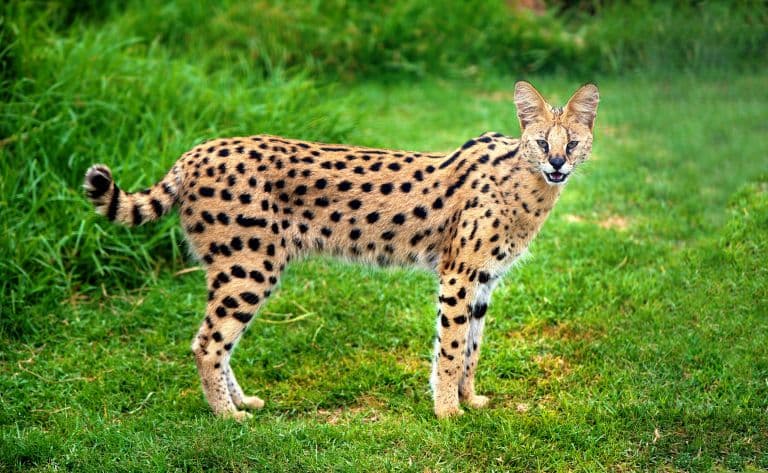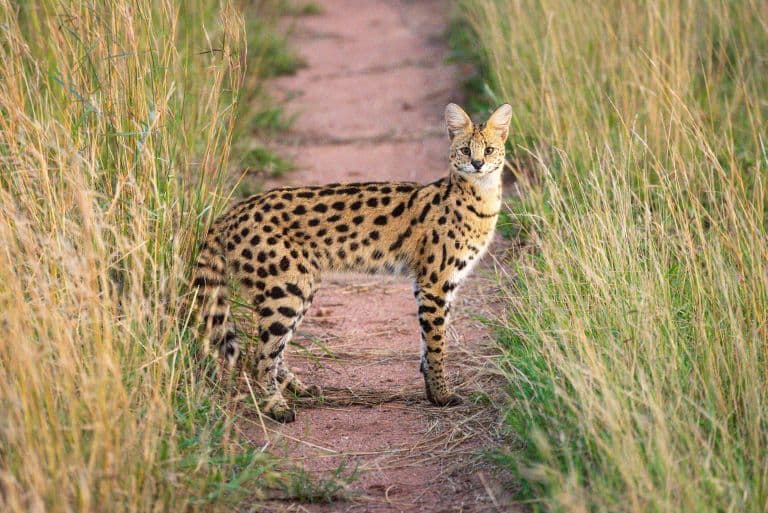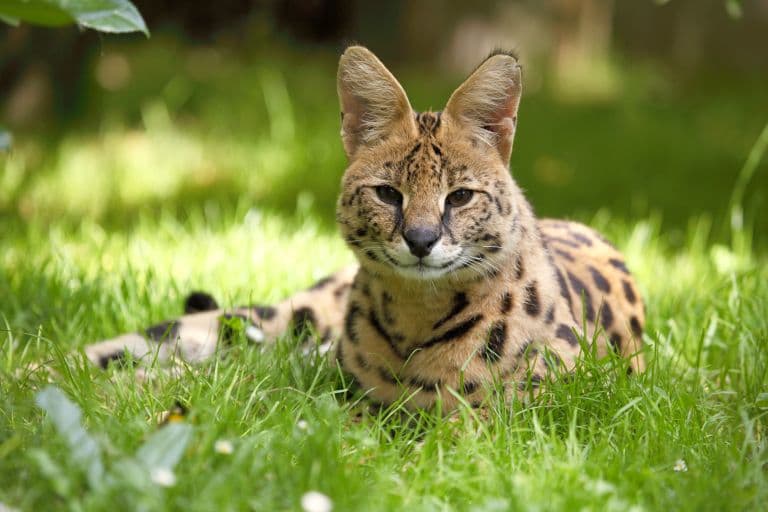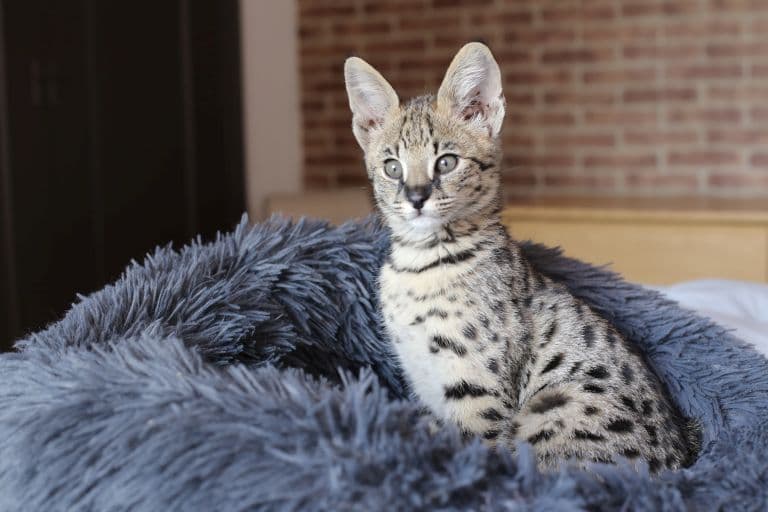Serval Profile
Africa has a woefully under-represented population of medium-sized predators that are rarely seen on TV and are of course overshadowed by the leopards and lions of the savanna.
Yet, much like the homes of the ocelots and margays of Central and South America, there are niches in African grasslands filled with elegant, enigmatic and just plain weird predators. Some are bug-eyed, badger-like viverrids like the civet and genet, others, like the side-striped jackal are more familiar.
But there’s also a whole range of wild cats that deserve attention and the serval is a great one to start with. These slender, medium-sized cats are widespread in sub-Saharan countries.

Serval Facts Overview
| Habitat: | Grasslands, moorlands, bamboo thickets |
| Location: | Sub-Saharan Africa, North Africa |
| Lifespan: | 10 years in the wild, 20 in captivity |
| Size: | 62cm (22 inches) at the shoulder |
| Weight: | Up to 18kg (40lb) |
| Colour: | Golden yellow with black spots |
| Diet: | rodents, small birds, hares, frogs, insects, reptiles, occasionally larger prey |
| Predators: | Hyenas, wild dogs |
| Top Speed: | Unknown |
| No. of Species: | 1 |
| Conservation Status: | Least Concern (IUCN) |
Servals look a little like wonky ocelots, in that they’re spotted and cat-like, but they’re quite different. Their lanky build and enormous ears make them unique among cats, and contribute to their formidable hunting prowess.
They are solitary carnivores and will hunt both day and night for rodents, such as rats, as well as frogs, reptiles, birds and insects.
They also don’t like the rainforest, and spend more time on its edge, in long grasses and marshland.
For this, they’re perfectly adapted, yet they’re still at risk of harm from the larger predators like hyenas and dogs. As such, they’re particularly elusive and skittish, making them hard to spot.
Interesting Serval Facts
1. Their name is derived from the word ‘Lynx’
It’s taken from (lobo-) cerval, which is Portuguese for lynx. Their genus name ‘Leptailurus’ is derived from the Greek λεπτός leptós meaning ‘fine’ or ‘delicate’ – and αἴλουρος aílouros meaning ‘cat’.

2. The serval has the longest legs of any cat relative to its body size
This is a medium-sized cat, and exploits the wealth of small mammals, birds, frogs and other animals that larger predators don’t have the agility for.
Servals hunt in thick, long grass and wetlands, and because of this, they’ve evolved remarkable stilt-like legs that make them look a bit gangly. But these cats are far from clumsy. They’re one of the most agile predators on the continent.
These legs are the longest of all cats, relative to their body-size, and are stretched out by the elongated bones in the foot.
Since cats walk on their tiptoes (digitigrade locomotion), these bones are further up the leg, and contribute to the serval’s height.
3. They can leap 10 feet in the air
This extra height is great for peeking over tall grasses, but the legs of the serval are also specialised for leaping. Servals can easily jump over three meters straight up, giving them the ability to bring down large birds, as well as terrestrial animals.
They also have flexible, elongated necks, which adds to their bizarre look, but is a great adaptation to peering, pouncing and grabbing. 1
4. They have enormous ears that can rotate 180 degrees
On top of all this, the serval has a huge pair of ears. These are independently controlled and can rotate a full 180 degrees to monitor their surroundings. All the better for hearing you with, but the ears also convey a message to others.
On the back of each ear is a distinctive white spot, and while the purpose for these spots is not certain, it’s thought they may be false eyes, giving potential predators second-thoughts before sneaking up on the cat.
Otherwise, they could also be contrasting patterns that are easy to spot, helping kittens keep track of mum while she’s off in the long grass.

5. They’re successful hunters
These adaptations add up to an elite hunting machine, and servals have one of the highest kill rate of any cat. Of course, the internet being what it is, this rate can be anywhere from 40% to 98%, depending on where you look, but an impressive rate of 48% from a paper in 1984 provides the most reliable source on this.
Small mammals are the majority of the prey of the serval, ranging in size up to around 8kg and going down to the pygmy mouse at 7g.
In fact, in classic cat form, the serval was found to have feasted on various species of mice to the point that in one survey they made up 95% of the predator’s diet. In other locations, particularly in wetlands, frogs make up a significant portion of the meals.
Mice are first identified using those enormous ears, and then attacked from above at the end of a tremendous pounce from behind the tall grasses. The impact of the pounce is usually enough to take out smaller prey.
But servals will also take snakes, birds, hares, and various other animals, which they will initially swipe with a powerful paw and then kill, once incapacitated, with a bite to the neck. 2
6. They eat da poo poo
Interestingly, dung and grass make up a portion of the serval’s diet, and while this isn’t likely to provide much in the way of nutrients, it’s thought that the feasting on these extra-nutritional items might serve some purpose in digesting all those mice.
This behaviour is more common than you might think in carnivores, and we commonly see it in our pets. While the old consensus was that it’s a way of making a cat or dog vomit up something they don’t want to digest (and this can still be true in some cases), it’s now well understood that these are legitimate fibre sources that make up part of a healthy digestive system.
Sadly, this can also be true for those of us with dogs who eat poop. As it turns out, this can actually be a healthy practice, as long as you don’t let them lick your face afterwards. 3
7. They communicate using urine
Serval are solitary wild cats and have home ranges of of 10 to 32 km2 (4 to 12 sq mi), which they mark with urine, feces and saliva.
Overlapping servals tend to avoid each other, and confrontations are rare.
They come together to mate once or twice a year with a short gestational period of 2-3 months. Litters of 1-4 kittens are born, and will stay with their mother until around a year old.
8. Servals can purr
Like a domestic cat and some other big cat species, servals can purr.
They can also hiss, grunt, meow and perform a growl when irritated.
9. Servals are doing fairly well
Globally, populations of serval aren’t considered threatened, and they’re not ion decline, either, but localised impacts have led to declines in subpopulations in places like South Africa, where intensive farming is causing them problems.
Servals actually do well in agricultural land. The scrubby areas provide a good home for lots of rodents, and servals provide a welcome service in getting rid of them. On top of this, farmland is less likely to have some of the larger predators that compete with the smaller cat.
But in places where poisons are used to deter various pests, and where even the rodent populations are in decline from destructive farming practices, servals aren’t doing as well.
However, they have been successfully reintroduced to various national parks and stand a good chance at remaining stable, globally.
10. There’s a serval hybrid known as the Savannah cat
In 1986, the first hybrid between a male serval and a female domestic cat was born that is known as the savannah cat.
They are larger than a domestic cat, and have the coat pattern of the father serval. However, they also had domestic cat traits, such as tameness and are known for their loyalty.
In 2001, the International Cat Association approved the breed. In many states in the USA, it’s permitted to own the hybrid savannah cat. 4

Serval Fact-File Summary
Scientific Classification
| Kingdom: | Animalia |
| Phylum: | Chordata |
| Class: | Mammalia |
| Order: | Carnivora |
| Family: | Felidae |
| Subfamily: | Felinae |
| Genus: | Leptailurus |
| Species: | Leptailurus Serval |
Fact Sources & References
- Dallas Zoo (2015), “Dallas Zoo’s Serval Cat Makes Impressive Jump”, YouTube.
- “Serval”, Syabona Africa.
- Geertsema, A.A. (1984), “Aspects of the Ecology of the Serval Leptailurus Serval in the Ngorongoro Crater, Tanzania.”, Sci Hub.
- “Savannah Breed“, TICA.
